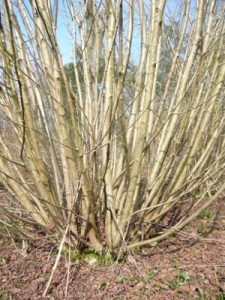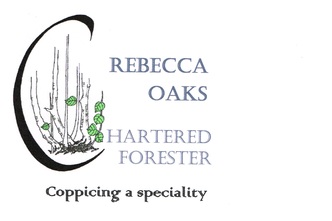Coppicing
 Coppicing is the perfect sustainable woodland management system. All of our native hardwood trees will coppice, when they are cut off to the ground they produce multiple shoots which will grow into a multistemmed tree. In the case of hazel which is a native shrub that grows widely across the country, it will produce many rods which can be cut on a fairly short rotation such as six to nine years. The rotation is the length of time between cutting. If you have a big enough woodland you can divide it into the number of years that your coppice is to grow and cut one area or coupe, each year until you are back to the beginning. This produces a mosaic of coppice at different stages from clear cut through to canopy closure (when the trees or shrubs are so well grown that the tree tops touch creating total shade underneath). The mosaic of different stages provides a wide range of habitat for plants, insects and animals and enhances the diversity of the woods. The only snag is that browsing animals such as deer will eat the regrowth and spoil it as a future crop so fencing is usually essential.
Coppicing is the perfect sustainable woodland management system. All of our native hardwood trees will coppice, when they are cut off to the ground they produce multiple shoots which will grow into a multistemmed tree. In the case of hazel which is a native shrub that grows widely across the country, it will produce many rods which can be cut on a fairly short rotation such as six to nine years. The rotation is the length of time between cutting. If you have a big enough woodland you can divide it into the number of years that your coppice is to grow and cut one area or coupe, each year until you are back to the beginning. This produces a mosaic of coppice at different stages from clear cut through to canopy closure (when the trees or shrubs are so well grown that the tree tops touch creating total shade underneath). The mosaic of different stages provides a wide range of habitat for plants, insects and animals and enhances the diversity of the woods. The only snag is that browsing animals such as deer will eat the regrowth and spoil it as a future crop so fencing is usually essential.
History
 Modern coppice businesses have had to be inventive to find alternative uses for coppice products.Coppicing has been carried out for as long as people have been using trees for providing all their needs. Some of the earliest evidence for coppicing comes from the Somerset levels where trackways made of even aged poles were found preserved in the peat that date back over 3000 years. More recently, woven panels were used in the construction of wattle and daub houses and the hazel hurdle industry is recorded in the section on hurdles. Charcoal burning used a huge amount of coppice wood, from the Iron Age onwards charcoal was used to create the high temperatures needed to smelt metal. At the peak of the industrial revolution huge areas of the country were regularly being coppiced to provide enough charcoal for the furnaces. Eventually coke and coal took over and the charcoal industry declined. It was still being used for gunpowder until the twentieth century. Oak that was felled for charcoal also had its bark removed as the bark was an essential ingredient for the tanning industry. There are still a couple of tanneries using oak bark to make high quality leather. Some of the industries in the twentieth century that depended on coppice wood were bobbin mills that made the cotton reels for the textile industry. Crate wood for packing ceramics in the Staffordshire potteries. Ships fenders which needed 1000’s of bundles of brush wood to keep ships from being damaged when they were up against the quay. Thatching is a traditional skill that needs huge numbers of hazel spars, which are split hazel used to pin the straw in place.
Modern coppice businesses have had to be inventive to find alternative uses for coppice products.Coppicing has been carried out for as long as people have been using trees for providing all their needs. Some of the earliest evidence for coppicing comes from the Somerset levels where trackways made of even aged poles were found preserved in the peat that date back over 3000 years. More recently, woven panels were used in the construction of wattle and daub houses and the hazel hurdle industry is recorded in the section on hurdles. Charcoal burning used a huge amount of coppice wood, from the Iron Age onwards charcoal was used to create the high temperatures needed to smelt metal. At the peak of the industrial revolution huge areas of the country were regularly being coppiced to provide enough charcoal for the furnaces. Eventually coke and coal took over and the charcoal industry declined. It was still being used for gunpowder until the twentieth century. Oak that was felled for charcoal also had its bark removed as the bark was an essential ingredient for the tanning industry. There are still a couple of tanneries using oak bark to make high quality leather. Some of the industries in the twentieth century that depended on coppice wood were bobbin mills that made the cotton reels for the textile industry. Crate wood for packing ceramics in the Staffordshire potteries. Ships fenders which needed 1000’s of bundles of brush wood to keep ships from being damaged when they were up against the quay. Thatching is a traditional skill that needs huge numbers of hazel spars, which are split hazel used to pin the straw in place.

